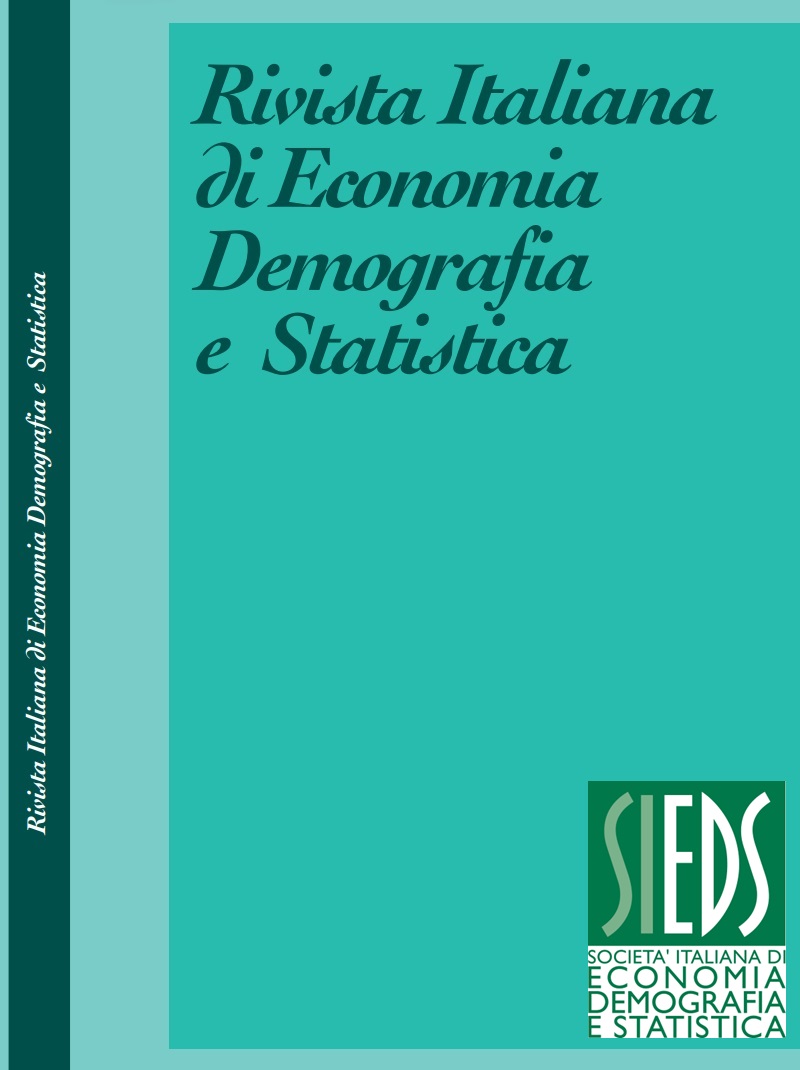Rethinking Italian inner areas: lessons from the potential demography
DOI:
https://doi.org/10.71014/sieds.v79i1.309Abstract
The National Strategy for Inner Areas (NSIA) categorizes Italian municipalities based on their distance from "poles", i.e. centres providing essential services. Inner areas (IAs) are municipalities located within a certain distance from the poles. Although the NSIA aims to counteract depopulation and ageing processes affecting IAs, traditional demographic indicators, as the ones officially released by Istat annually, have not been considered to identify them.
For this reason, we aim to provide a demographically nuanced representation of IAs. In particular, we exploit the concepts of potential demography to delineate a demographic profile of the Italian IAs, both in actual and predictive terms. The idea of Potential Years of Life is used to assess the future economic potential of the IAs' population.
The preliminary application shows a complex situation that the NSIA classification failed to capture. A discrepancy between the IAs experiencing the strongest demographic distress and the territories receiving national funding has emerged.
References
BARCA F., CASAVOLA P., LUCATELLI S. 2014. Strategia Nazionale Per le Aree Interne. Definizioni, Obiettivi e Strumenti di Governance. Materiali UVAL 2014.
BARCA, F., CARROSIO, G. 2020. Un modello di policy place-based: la Strategia Nazionale per le Aree Interne. In OSTI. G. AND JACHIA E. (Eds.) Un disegno di rinascita delle aree interne, Il Mulino, Bologna.
BITONTI F., MAZZA A., MUCCIARDI M., SCROFANI L. 2023. Urban transformations and the spatial distribution of foreign immigrants in Messina. In E. BRENTARI E., CHIODI M., WIT E. (Eds). Models for Data Analysis: SIS 2018, Palermo, Italy, June 20–22. Cham: Springer International Publishing, pp. 53-67. DOI: https://doi.org/10.1007/978-3-031-15885-8_5
BLANGIARDO G.C. 2013. Italians of today and tomorrow: awareness of next scenarios and search of new equilibrium. Rivista Italiana di Economia, Demografia e Statistica, Vol.17, No.2.
BLANGIARDO G.C. 2012. Discovering the "Demographic GDP". Rivista Internazionale di Scienze Sociali, Vol.1, pp.45-58.
BLANGIARDO G.C., RIMOLDI S.M.L. 2012. The potential demography: a tool for evaluating differences among countries in the European Union. Genus, Vol.68, No.3, pp.63-81.
DE MATTEIS G. 2013. Montagne e aree interne nelle politiche di coesione territoriale italiane ed europee. Territorio, Vol.66, pp.7-15. DOI: https://doi.org/10.3280/TR2013-066001
HERSCH L. 1944. De la démographie actuelle à la démographie potentielle, Publications de la Faculté des Sciences Économiques et Sociales, 8. Université de Genève.
ISTAT. 2022. La geografia delle aree interne nel 2020: vasti territori tra potenzialità e debolezze. https://www.istat.it/it/files//2022/07/FOCUS-AREE-INTERNE-2021.pdf. Last Access: 21.11.2023.
NOTA TECNICA NUVAP. 2022. Aggiornamento 2020 della mappa delle aree interne. 20220214-mappa-ai-2020-nota-tecnica-nuvap_rev.pdf.
PANUSH N., PERITZ E. 1996. Potential demography: a second look. European Journal of Population / Revue Européenne de Démographie, Vol.12, No.1, pp.27-39. DOI: https://doi.org/10.1007/BF01797164
R CORE TEAM. 2023. R: A Language and Environment for Statistical Computing. R Foundation for Statistical Computing, Vienna, Austria. https://www.R-project.org/.
REGIONE SICILIA. 2022. Strategie Territoriali Regione Siciliana 2021-2027.
SCROFANI L., NOVEMBRE C. 2015. The inland areas of Sicily. From rural development to territorial reorganization. Semestrale di Studi e Ricerche di Geografia Roma - XXVII, 1, gennaio-giugno.
TANTILLO F., LUCATELLI S. 2018. La Strategia nazionale per le aree interne. Riabitare l'Italia. Le Aree Interne Tra ab-Bandoni e Riconquiste. In DE ROSSI A. (Ed). Rome: Donzelli Editore, pp. 403–416.
VENDEMMIA B., PUCCI P., BERIA P. 2021. An institutional periphery in discussion. Rethinking the inner areas in Italy. Applied Geography, Vol.135, No.102537. DOI: https://doi.org/10.1016/j.apgeog.2021.102537
Downloads
Published
Issue
Section
License
Copyright (c) 2025 Francesca Bitonti, Angelo Mazza

This work is licensed under a Creative Commons Attribution 4.0 International License.



